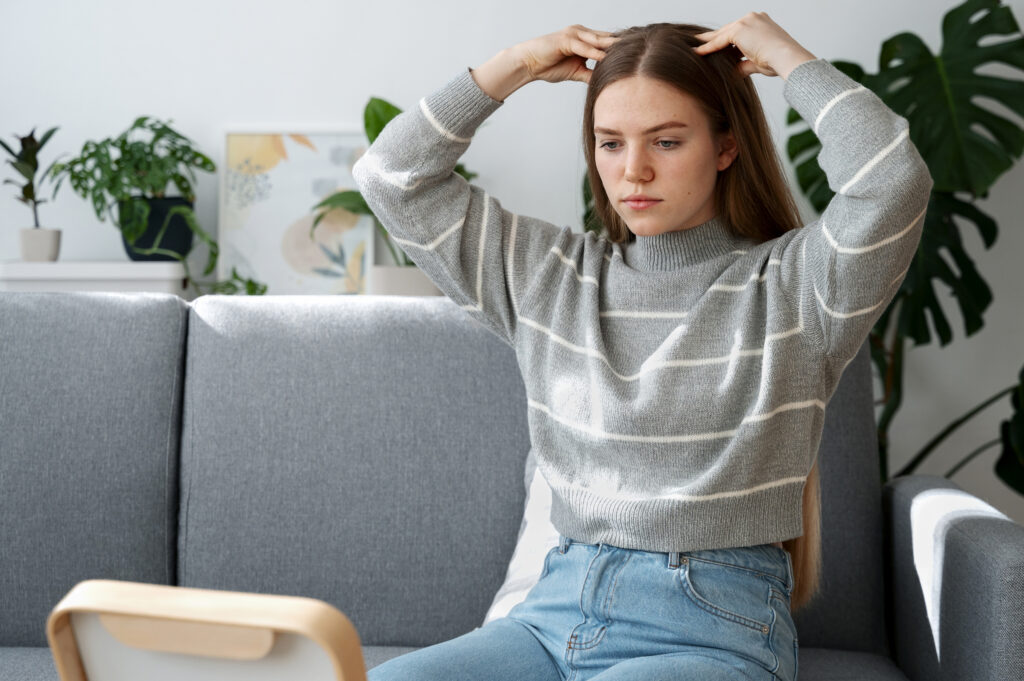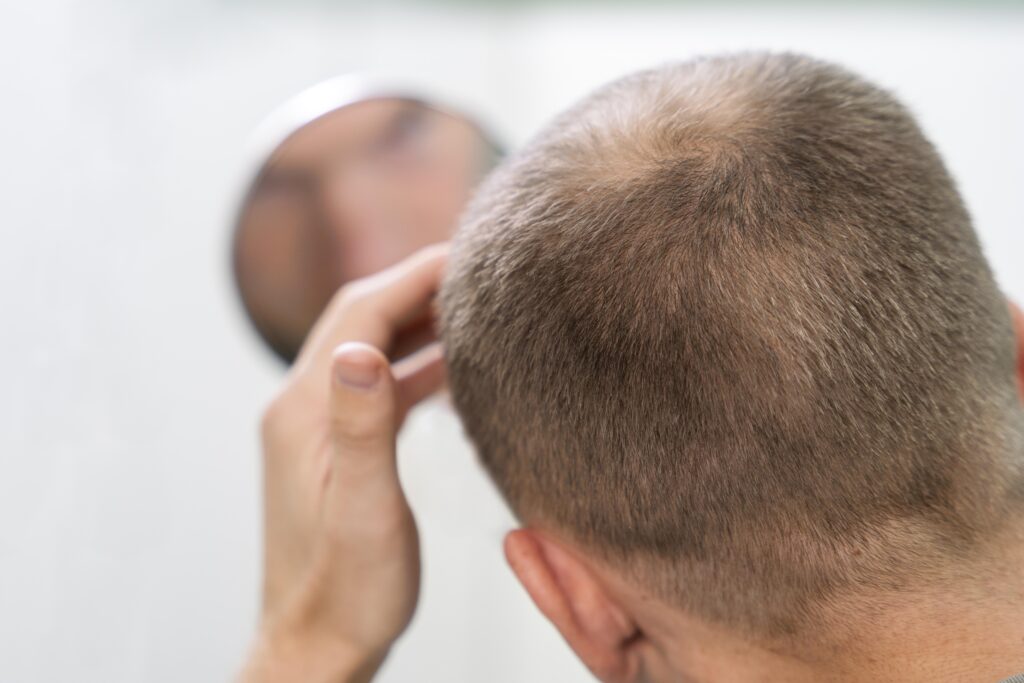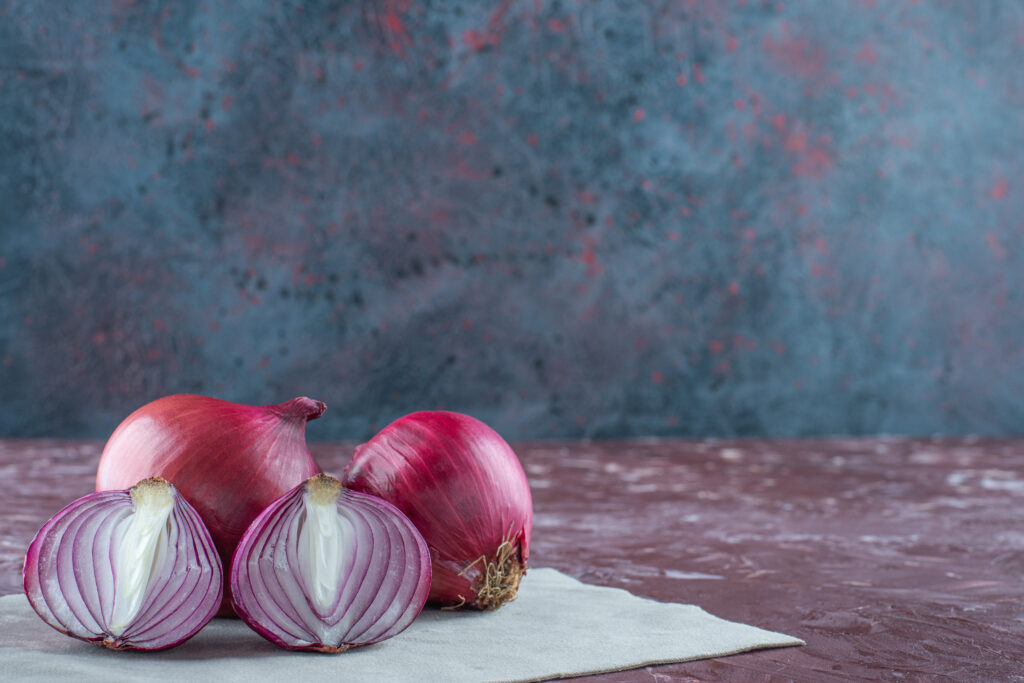Scalp massage is more than just a relaxing experience—it’s a powerful practice that can enhance your hair health, reduce stress, and promote overall well-being. By stimulating blood flow to the scalp, this ancient technique offers a multitude of benefits, from encouraging hair growth to relieving tension headaches. this has been proved by numerous studies and researches like this self structured study published in 2019
Table of Contents
What is Scalp Massage?
Scalp massage is a therapeutic technique that involves gentle kneading, rubbing, and stroking of the scalp. This practice boosts blood circulation to the hair follicles, promoting hair growth and overall scalp health. Beyond its physical benefits, scalp massage also reduces stress and tension, providing a calming and relaxing experience. Whether performed with hands or specialized tools, scalp massage is a simple yet effective way to enhance your hair care routine.
Benefits of Scalp Massage
- Improved Blood Circulation:
- Scalp massage enhances blood flow to the skin and dermal layers, ensuring that hair follicles receive more oxygen and essential nutrients. This increased circulation supports healthy hair growth and scalp health.
- Enhanced Sebum Production:
- Gentle massage stimulates sebaceous glands, promoting the production of sebum, the natural oil that moisturizes the scalp and hair. This helps to keep the scalp hydrated and prevents dryness and flakiness.
- Exfoliation and Dead Skin Removal:
- The massaging action helps in the removal of dead skin cells from the scalp surface, preventing the buildup of flakes and dandruff. This exfoliation process keeps the scalp clean and unclogged.
- Stimulation of Dermal Papilla Cells:
- Scalp massage activates dermal papilla cells at the base of hair follicles. These cells play a critical role in hair growth by providing the necessary signals for the hair follicle to enter the anagen (growth) phase.
- Reduction of Inflammation:
- Regular scalp massage can help reduce inflammation in the scalp skin. The gentle pressure applied during massage promotes lymphatic drainage, which helps in reducing swelling and the build-up of inflammatory substances in the dermis.
- Increased Collagen Production:
- The mechanical stimulation of the scalp can boost collagen production in the dermal layer. Collagen is vital for maintaining the structure and elasticity of the skin, including the scalp, which supports healthy hair growth.
- Relaxation and Stress Relief:
- Beyond the physical benefits, scalp massage can also reduce stress levels by promoting relaxation. Lower stress levels contribute to better overall skin health, as stress can exacerbate skin conditions like psoriasis and dermatitis.
- Enhanced Absorption of Hair Products:
- Massaging the scalp increases the skin’s permeability, allowing hair care products like oils, serums, and treatments to penetrate more effectively. This ensures that active ingredients reach deeper layers of the skin and hair follicles for better results.
By addressing these various aspects, scalp massage serves as a holistic approach to improving scalp and hair health from the surface layer down to the deeper dermal structures.
Technique 1: Pinching
First wash your hands thoroughly and ensure your nails are trimmed to avoid any accidental scratching. Start off by warming up your scalp by rubbing slowly starting from back of head and then moving towards sides and lastly the top and front hairline. do this for 2 minutes until you can feel a sense of warmth in your scalp. Now;
- Using your thumb and index finger, gently pinch a small section of scalp. Begin at the front of your hairline or near your temples.
- The pinch should be firm enough to lift the skin slightly, but not so hard that it causes discomfort or pain.
- Once you have a small section pinched, gently tug and release the skin in a rhythmic motion.
- Move your fingers in small circular or back-and-forth motions while maintaining the pinch.
- Work your way across the entire scalp, pinching small sections at a time. Ensure you cover all areas, including the sides, top, and back of the head.
- Spend about 1-2 minutes on each section to ensure thorough stimulation.
- Adjust the pressure based on your comfort level. The technique should feel invigorating but not painful. If you feel any discomfort, reduce the pressure.
- Once you have massaged the entire scalp, gently run your fingers through your hair to relax the scalp and redistribute any oil that was applied.
- Finish with a few gentle strokes using the pads of your fingers to smooth and soothe the scalp.
- For best results, perform this pinching technique 2-3 times a week. Consistency will help maximize the benefits of increased blood flow and scalp stimulation.
Technique 2: Pressing
- Using the pads of your fingertips, place your hands on your scalp. Start at the base of your skull or at the hairline near your forehead.
- Apply gentle but firm pressure with your fingertips, pressing into the scalp without causing discomfort.
- With the pressure applied, make small circular motions with your fingertips. This helps stimulate the scalp and promote blood flow.
- Maintain consistent pressure as you move your fingers in circles, ensuring each press is firm but not painful.
- Work your way across the entire scalp, section by section. Start from the base of the skull or forehead and move towards the crown of the head, then outwards to the sides.
- Spend about 1-2 minutes on each section to ensure thorough stimulation and relaxation.
- Adjust the pressure based on your comfort level. The pressing technique should feel relaxing and invigorating but not uncomfortable. If you experience any pain, reduce the pressure.
- Once you have massaged the entire scalp, gently comb through your hair with your fingers to relax the scalp further and redistribute any oil that was applied.
- Finish with a few gentle strokes using the pads of your fingers to smooth and soothe the scalp.
Technique 3: Stretching
- Place your hands on either side of your head, positioning your fingers on the scalp just above the ears.
- Gently grasp a section of your scalp with your fingertips, ensuring you have a firm but gentle hold.
- Gently pull the section of the scalp you are holding away from the skull, creating a stretching sensation. The movement should be slow and controlled.
- Hold the stretch for a few seconds (about 5-10 seconds) to allow the skin and underlying tissues to fully experience the stretch.
- Release the current section and move your hands to a new area. Continue stretching different sections of the scalp, working methodically from the front to the back and from one side to the other.
- Ensure you cover all areas of the scalp, including the crown and nape, to achieve a uniform stretching effect.
- Adjust the intensity of the stretch based on your comfort level. The stretching technique should create a mild tension but should not be painful. If you experience any discomfort, reduce the intensity of the stretch.
- For best results, perform the stretching technique 2-3 times a week. Consistent practice will help maximize the benefits of increased blood flow, scalp relaxation, and overall hair health.
By following this technique, you can effectively perform a stretching scalp massage that enhances blood circulation, reduces tension, and promotes relaxation and hair health.
Should you massage your scalp daily?
Massaging your scalp daily can be beneficial for your hair and skin. It boosts blood circulation, delivering essential nutrients and oxygen to the dermis layer of the scalp. This daily stimulation helps in faster cell turnover and tissue recovery, promoting healthier hair growth and reducing tension.
However, excessive scalp massage can lead to irritation and damage the delicate dermis layer. The cells and tissues need adequate recovery time to avoid over-stimulation. Limiting scalp massages to a few times a week ensures the benefits of improved circulation and relaxation without risking skin damage or inflammation.
Scalp Massage for Hair Growth: Myth or Reality?
Scalp massage has long been touted as a natural remedy for promoting hair growth. The idea is that massaging the scalp increases blood circulation to the hair follicles, delivering essential nutrients that encourage hair growth. Some studies suggest that regular scalp massages can indeed stimulate hair growth and improve hair thickness by enhancing blood flow and reducing stress, which can contribute to healthier hair.
However, while scalp massage offers many benefits, its effectiveness in significantly increasing hair growth remains debated. The reality is that while scalp massages can support a healthy scalp environment and may aid in hair growth to some extent, they are not a miracle cure for hair loss. Combining scalp massages with a balanced diet, proper hair care, and addressing any underlying health issues is essential for optimal hair growth and overall hair health.
A 2016 Study in the “ePlasty” Journal:
- Title: “Standardized Scalp Massage Results in Increased Hair Thickness by Inducing Stretching Forces to Dermal Papilla Cells in the Subcutaneous Tissue”
- Findings: This study found that standardized scalp massage over 24 weeks resulted in increased hair thickness, suggesting that the mechanical stretching force from scalp massage may induce hair growth.

Does scalp massage block DHT?
Now the most important concern for men and women suffering from androgenic alopecia is the hormone DHT. Dihydrotestosterone (DHT) is a potent androgen, a derivative of testosterone, playing a critical role in the development of male sexual characteristics. During puberty, DHT is responsible for the growth of body hair, deepening of the voice, and the increase in muscle mass. It also influences the development of the prostate and external genitalia.
Although DHT is essential for these processes, its excessive levels can lead to issues such as hair loss and prostate enlargement. It is said to be produced by testosterone under low oxygen conditions and deposits at the root of hair follicle causing hair thinning and eventually death of hair follicle. Therefore if one massages its scalp regularly and increase the flow of blood and in result oxygen to the scalp, testosterone would be converted to estradiol more instead of DHT preventive excessive hair thinning and hair loss.
Best Oils to Use for Scalp Massage
Using the best oils for scalp massage can enhance its benefits, promoting healthy hair growth and a nourished scalp. Essential oils like rosemary, peppermint, and lavender are popular choices. Rosemary oil stimulates hair follicles, encouraging growth. Peppermint oil improves blood circulation, which can strengthen hair roots. Lavender oil has soothing properties, reducing stress and improving scalp health. These oils not only nourish the scalp but also create a relaxing massage experience.
Carrier oils, such as coconut, jojoba, and argan oil, are excellent for scalp massage. Coconut oil deeply penetrates the scalp, providing essential nutrients and hydration. Jojoba oil mimics the scalp’s natural sebum, balancing oil production and preventing dandruff. Argan oil is rich in vitamins and antioxidants, promoting healthy hair growth and reducing inflammation. Combining these oils with essential oils can maximize the benefits of your scalp massage routine.
Tips and Precautions for Scalp Massage
When performing a scalp massage, start with clean hands and a clean scalp to prevent any infections. Use gentle, circular motions with your fingertips, avoiding excessive pressure to prevent irritation. Limit scalp massages to 5-10 minutes to avoid overstimulation. Incorporating essential oils like rosemary or peppermint can enhance the experience, but always do a patch test first to ensure you don’t have an allergic reaction.
It’s crucial to avoid using nails during the massage to prevent scratching and damaging the scalp. If you have any scalp conditions such as eczema or psoriasis, consult with a healthcare professional before starting scalp massages. Regular but not excessive scalp massages can boost blood circulation and promote relaxation, contributing to overall scalp and hair health.
Conclusion
Today, we explored the benefits of scalp massages and their various techniques, including pinching, pressing, and stretching. Scalp massages enhance blood circulation, reduce stress, and promote hair growth by stimulating hair follicles. Using the right oils can further amplify these benefits. Incorporating scalp massages into your routine can improve overall scalp health, making it a valuable addition to any hair care regimen.
Picture credits: Image by freepik




Nice content I’ve found here, I hope this will help my hair roots too for growing healthy hair strands.